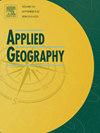Evolution of urban network patterns in the Yellow River Basin based on human mobility over 1,300 years
IF 4
2区 地球科学
Q1 GEOGRAPHY
引用次数: 0
Abstract
Human mobility has triggered changes in intercity relationships, reflecting transformations in the spatial structure of a region over time. The Yellow River Basin, a longstanding core region of China, has witnessed continuous development of cities influenced by natural and social environments. However, previous studies have not fully explored long-term changes in the relationships between cities in the area. This study focuses on cities within the historical boundaries of the Yellow River Basin. We extracted the spatiotemporal mobility information for these groups, utilising the trajectories of historical figures from the China Biographical Database. Using the gravity model and social network analysis, we constructed urban networks for seven historical periods spanning nearly 1300 years. Results indicate that the overall urban network in the Yellow River Basin exhibited a development pattern of “dual-centre–single-centre–multi-centre.” Overall, the layout of major cities in the Yellow River Basin transitioned from an “east-west orientation” to a “north-south orientation,” with the centre of the cities shifting from the southwest to the northeast. This study provides a new perspective on urban historical information mining and preservation of historical urban contexts in the basin.
1300年来基于人类流动的黄河流域城市网络格局演变
人口流动引发了城际关系的变化,反映了一个地区空间结构随时间的变化。黄河流域是中国长期以来的核心区,受自然环境和社会环境的影响,城市不断发展。然而,以往的研究并没有充分探讨该地区城市之间关系的长期变化。本研究的重点是黄河流域历史边界内的城市。我们利用中国传记数据库中的历史人物轨迹提取了这些群体的时空流动信息。利用重力模型和社会网络分析,我们构建了跨越近1300年的7个历史时期的城市网络。结果表明,黄河流域城市网络总体呈现“双中心-单中心-多中心”的发展格局。总体来看,黄河流域主要城市布局由“东西向”向“南北向”转变,城市中心由西南向东北转移。该研究为流域城市历史信息挖掘和历史城市文脉保护提供了新的视角。
本文章由计算机程序翻译,如有差异,请以英文原文为准。
求助全文
约1分钟内获得全文
求助全文
来源期刊

Applied Geography
GEOGRAPHY-
CiteScore
8.00
自引率
2.00%
发文量
134
期刊介绍:
Applied Geography is a journal devoted to the publication of research which utilizes geographic approaches (human, physical, nature-society and GIScience) to resolve human problems that have a spatial dimension. These problems may be related to the assessment, management and allocation of the world physical and/or human resources. The underlying rationale of the journal is that only through a clear understanding of the relevant societal, physical, and coupled natural-humans systems can we resolve such problems. Papers are invited on any theme involving the application of geographical theory and methodology in the resolution of human problems.
 求助内容:
求助内容: 应助结果提醒方式:
应助结果提醒方式:


